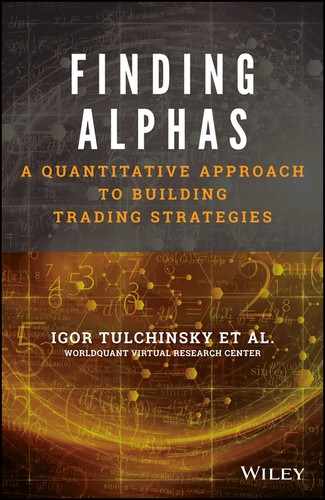27
Alphas and WebSim™ Fundamentals
By the WebSim™ Team
With the development of information technology, information processing, automatic trading, etc., the market is always close to 100% efficiency but is never at 100%. We seek to arbitrage profit from this inefficiency.
It is difficult to predict one stock’s future return. One stock error due to noisy data will not hurt the whole performance. The process of betting many stocks every day is called statistical arbitrage, which is what WebSim™ does.
Statistical arbitrages are also called alphas. A good statistical arbitrage model usually involves a large number of securities and may have short holding periods, with positive returns expected in the long run.
ALPHAS AND WEBSIM™
An alpha is a mathematical, predictive model of the performance of financial instruments (e.g. stocks, futures contracts, etc.) that can be simulated historically using WebSim™. This model is comprised of data (e.g. close price, open price, volume, etc.) and mathematical expressions (+/–, StdDev(x, n), regression, etc.).
WebSim™ is a web-based simulator of global financial markets that was created to explore alpha research. It will accept an alpha expression/Python code as input and will plot its PnL as its output. The input expression is evaluated for each financial instrument, every day (history dates), and a portfolio is constructed accordingly. WebSim™ invests in each financial instrument to the value of the expression. It either takes a long or short position, based on which a PnL graph is plotted, as can be seen in Figure 27.1.

Figure 27.1 The generation of a PnL graph in WebSim™ simulator
Since the PnL is generated for historical data, it is called the In-Sample PnL. After the alpha is submitted, it has to pass some criteria set by WebSim™. If it passes the criteria, it will be evaluated against real-time data for a period known as Out-Sample (OS) period. The PnL generated in this case, as seen in Figure 27.2, is called OutSample PnL

Figure 27.2 Out-Sample PnL generated in WebSim™
For assembling alphas into a portfolio, different weights are placed on different alphas. The weights are then scaled to book size when calculating PnL. These weights are not constants; they change over time based on the current information and the history of the changes of some variables (such as prices, volumes, etc.).
ALPHA SOURCES
Alpha ideas can be found online via research papers, finance journals, and technical indicators.
Technical indicators are used for analyzing short-term price movements. They are derived from generic price activity in a stock/asset. They predict the future price levels or the general price direction of a security by looking at the past patterns. Examples of common technical indicators are Relative Strength Index, Money Flow Index, MACD, Bollinger Bands, etc. You can find their explanation, formulae, and corresponding interpretation in websites like Stock Charts, Incredible Charts, etc.
SSRN is a good place to start if you are looking for alpha ideas. And so are websites like Seeking Alpha and Wilmott.
Blogs are a good source of alpha research too, e.g. Epchan, AuTraSy, etc.
Concepts to explore:
- Price movement and technical indicator.
- Volatility measures – historical volatility, implied volatility, volatility index, intraday volatility, etc.
- Volume’s interaction with price – volume is positively correlated with absolute price changes, etc.
- Short-term and long-term trends – http://www.investopedia.com/articles/technical/03/060303.asp.
The user should note that any reference to third-party sites above is for the user’s convenience only. Users should read and abide by the terms of use of these sites.
NEUTRALIZATION
Neutralization is an operation in which the raw alpha values are put into various groups, followed by normalization (the mean is subtracted from each value) within each group. The group can be the entire market. Or the groups could be made using other classifications like industry or sub-industry (based on SIC and NAICS codes). This is done so as not to bet in the direction of the chosen group, but only relative stock future return. As a consequence of neutralization, the entire portfolio carries neutral position (half long, half short). Doing this will guard the portfolio from market shocks and eliminate some kinds of false signals.
UNIVERSE
The simulation universe consists of the instruments to be evaluated and the dates over which evaluations are done. WebSim™ only trades liquid stocks. WebSim™ provides standard universes like TOP3000, TOP2000, TOP1000, etc.
The TOP-N universes are comprised of N stocks of the region with the highest average dollar volume over the past three months. For example, in the top liquid universes, TOP3000 is a set of 3,000 stocks with highest liquidity in a three-month period; TOP2000 is a set of 2,000 stocks with highest liquidity in a three-month period; and so on. TOP2000 is a subset of TOP3000 stocks.
